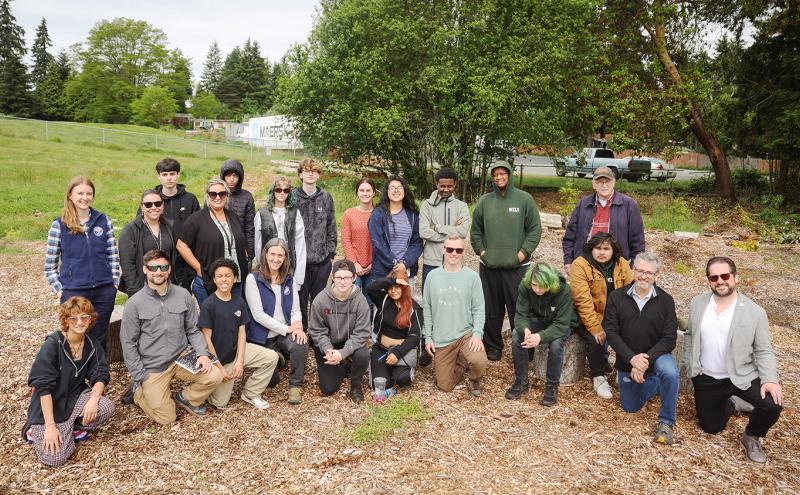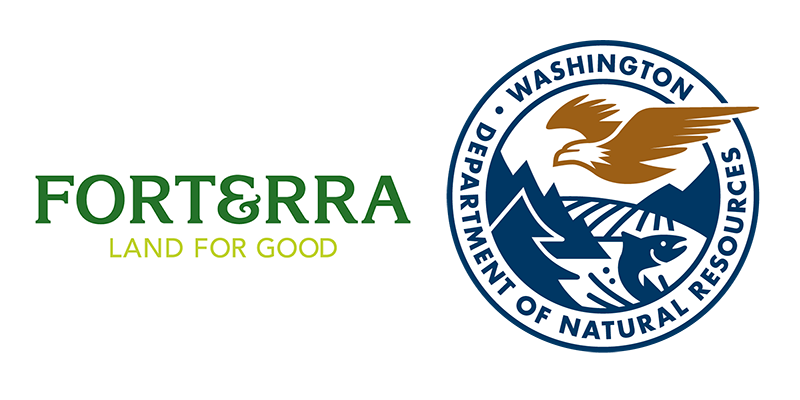
Highlights:
- Port of Seattle investment of $450,000 allowed Highline Public Schools, Washington Department of Natural Resources and Forterra to secure an additional $300,000 for tree canopy enhancement projects
- Expanded support was critical and helped create a scalable model to restore and increase tree canopy beyond public parks
- Healthy green spaces strengthen neighborhoods and provide safe access to nature
- Student-led projects highlight the power of community partnerships
Burien, WA – The Port of Seattle, the Washington State Department of Natural Resources (DNR), students from Waskowitz Environmental Leadership & Service (WELS) program in Highline Public Schools and Forterra gathered in an ongoing effort to restore and expand forest canopy.
In 2016, the Port of Seattle launched a program to increase funding for environmental stewardship projects near the airport. A portion of the funding supported a detailed study by Forterra of the tree canopy in three near-airport cities. The study made it clear that communities in SeaTac, Burien, and Des Moines needed more trees on or within a quarter mile of select public schools to provide shade and improve air quality. In addition to the study, the Port provided funding to local community organizations to support urban forestry and efforts to expand tree canopy in the three cities.
“Six years ago, the Port launched Airport Community Ecology or ACE Fund. This $1 million fund was created in recognition that people living in Burien, SeaTac and Des Moines experience significant impacts from the airport, and that additional tree cover is one way the Port can help improve the quality of life and environment in these communities,” said Port of Seattle Commissioner, Fred Felleman.
“Approximately half the fund was distributed in grants to community groups who completed 33 projects over this time. The balance of the ACE Fund went to Forterra to expand its Green Cities Partnership and this Urban Canopy study will be used to guide long-term planning for trees in communities closest to the airport.
“It’s a testament to the cities and community groups in SeaTac, Des Moines, and Burien who embraced this research by Forterra and turned a planning effort into a significant tree planting effort. This project will help reduce heat, improve air quality, absorb carbon to the benefit of the communities’ quality of life.”
Thanks to the initial investment of $450,000 from the Port of Seattle, Forterra secured an additional $300,000 in funding for canopy enhancement projects in collaboration with Highline Public Schools and the DNR. The funding originally came from a $300,000 Landscape Scale Restoration Grant from the USDA Forest Service, $260,000 of which was passed from DNR to Forterra for work in the Highline School District. This funding enabled the program to increase canopy on or within one quarter mile of select public schools in SeaTac, Burien, and Des Moines. Students at WELS, which houses one of the projects, highlight the power of support for community partnerships. Forterra developed a student-based engagement model and trained students to lead and engage peers and community members in urban forestry. So far, the WELS project has engaged dozens of community volunteers, planted more than 500 native plants and, through a partnership with a local foodbank, increased access to healthy produce by creating and expanding garden beds to grow food.
“At WELS our curriculum is anchored by “Impact Projects” that provide opportunity for students to be in the field, working with community partners to create solutions and make a positive impact,” said Michael-Stein Ross, Teacher of Outdoor Recreation and Leadership at WELS. “This Tree Canopy project was a year-long undertaking for our students, rich in opportunities for career exploration, 21st century skill building, and authentic subject matter connections. The best part for me as a teacher, was to see how a project like this is a healing approach to learning – being outside, working with nature in community with others has been a salve for the trauma our students have been carrying throughout the pandemic.”
Financial support and guidance to expand forest assessment work and programmatic focus beyond public parks from the Port has been critical and helped create a scalable model to restore and increase tree canopy.
A map of tree coverage within a quarter mile of schools in Burien is below.

About Forterra
Forterra is an unconventional land trust that works across Washington’s communities and landscapes, from the ranches and shrub-steppe of the Yakima basin, to the estuaries, farms and forests of Washington’s coast, reaching more than 100 counties, cities, towns and rural communities. Working cooperatively with people and nature, Forterra drives land stewardship, management and planning; innovative programs and policies; farming and forestry approaches; community ownership opportunities; and development solutions. To learn more about Forterra’s conservation efforts, visit forterra.org.

Contacts
Heidi Taffera
Managing Director of Media Relations and Storytelling, Forterra
[email protected]
(425)269-9981
Perry Cooper
SEA Airport Media Officer
[email protected]
(206)787-4923

